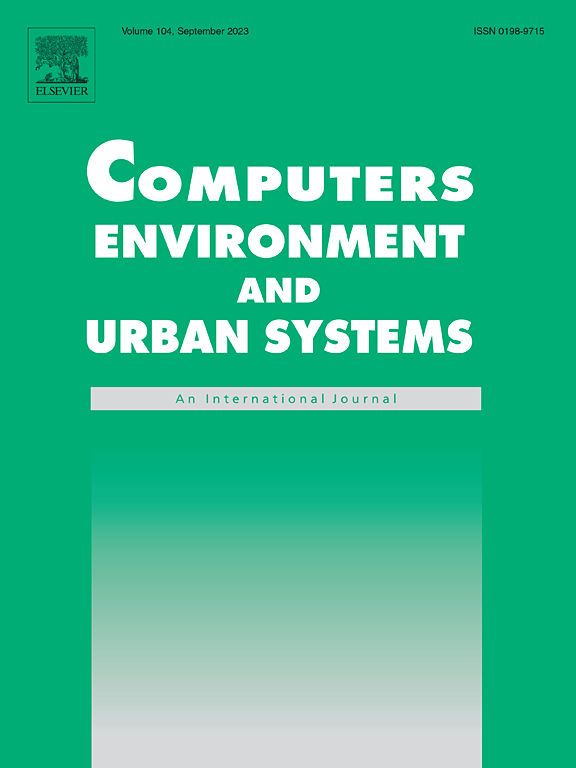Advancing population-targeted urban sensing: A comparative study on mobile and static sensing paradigms
IF 7.1
1区 地球科学
Q1 ENVIRONMENTAL STUDIES
Computers Environment and Urban Systems
Pub Date : 2025-04-08
DOI:10.1016/j.compenvurbsys.2025.102288
引用次数: 0
Abstract
To evaluate human exposure to environmental factors, sufficient population-targeted sensing power of sensor carriers is crucial. However, the traditional static sensing approach is constrained by its limited coverage. Recently, equipping moving vehicles with sensors has emerged as a new approach. However, a quantitative comparison between mobile and traditional static sensing is still lacking. Using empirical taxi trajectory and population data in Beijing and Xiamen, we found that while a small number of taxi-based mobile sensors can cover a larger portion of the population, well-located static sensors eventually surpass mobile sensors in coverage as their number increases. In addition, a higher required frequency reduces the coverage of mobile sensors, whereas a higher cost ratio between static and mobile sensors reduces the coverage of static sites. Taxis provide extensive spatial coverage but with some uncertainty, especially in peripheral areas, whereas static sensors ensure localized and stable coverage. Based on the advantage of taxis and static sites, we propose an effective greedy-add-guided strengthen elitist genetic algorithm to determine the optimal combination of static and mobile sensors. The key idea is to position static sensors in areas with relatively low taxi visit probabilities but high population density. The results indicate that this optimal combination achieves higher population coverage compared to using taxis alone. It addresses the uncertainty in taxi coverage and significantly reduces the number of sensors required. These results support the feasibility of using taxis as a sensing paradigm and further highlight the potential of combining these two sensing paradigms in population-targeted sensing applications.
推进以人口为目标的城市感知:移动与静态感知范式的比较研究
为了评估人类对环境因子的暴露,传感器载体具有足够的人群感知能力至关重要。然而,传统的静态传感方法受限于其有限的覆盖范围。最近,为移动车辆配备传感器已成为一种新方法。然而,移动传感与传统静态传感之间的定量比较仍然缺乏。利用北京和厦门的出租车轨迹和人口数据,我们发现,虽然少量基于出租车的移动传感器可以覆盖大部分人口,但位置良好的静态传感器最终会随着数量的增加而覆盖范围超过移动传感器。此外,更高的频率要求降低了移动传感器的覆盖范围,而更高的静态和移动传感器之间的成本比降低了静态站点的覆盖范围。出租车提供了广泛的空间覆盖,但也有一些不确定性,尤其是在周边地区,而静态传感器则确保了局部和稳定的覆盖。基于出租车和静态站点的优势,我们提出了一种有效的贪婪添加导向强化精英遗传算法来确定静态和移动传感器的最优组合。关键思想是将静态传感器定位在出租车访问概率相对较低但人口密度较高的地区。结果表明,与单独使用出租车相比,这种优化组合实现了更高的人口覆盖率。它解决了出租车覆盖范围的不确定性,并显著减少了所需传感器的数量。这些结果支持了出租车作为一种感知范式的可行性,并进一步强调了将这两种感知范式结合起来用于人群目标感知应用的潜力。
本文章由计算机程序翻译,如有差异,请以英文原文为准。
求助全文
约1分钟内获得全文
求助全文
来源期刊

Computers Environment and Urban Systems
Multiple-
CiteScore
13.30
自引率
7.40%
发文量
111
审稿时长
32 days
期刊介绍:
Computers, Environment and Urban Systemsis an interdisciplinary journal publishing cutting-edge and innovative computer-based research on environmental and urban systems, that privileges the geospatial perspective. The journal welcomes original high quality scholarship of a theoretical, applied or technological nature, and provides a stimulating presentation of perspectives, research developments, overviews of important new technologies and uses of major computational, information-based, and visualization innovations. Applied and theoretical contributions demonstrate the scope of computer-based analysis fostering a better understanding of environmental and urban systems, their spatial scope and their dynamics.
 求助内容:
求助内容: 应助结果提醒方式:
应助结果提醒方式:


